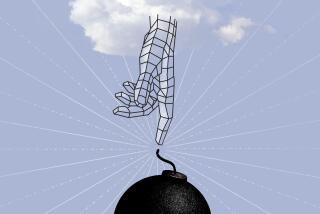Analysts Call for a Clear Sun Strategy
- Share via
It’s been three years since Sun Microsystems Inc. made any real money, but the computer company whose products powered the dot-com boom has continued to enjoy a surprising degree of respect in Silicon Valley and tolerance on Wall Street.
The goodwill may run out today, when Sun is expected to report a loss of as much as 10 cents a share for its fiscal first quarter.
In fact, many are already questioning whether Sun and its brash chief executive, Scott McNealy, can pull out of a slump that has knocked the Santa Clara, Calif., company’s stock to $3.79 -- from $64 in September 2000. Since June, as other tech stocks have rallied, Sun has sagged.
“Sun needs to moderate its rebel stance a little,” said Gartner Inc. analyst Daryl Plummer. “They haven’t had a clear strategy for virtually any way to make money.”
For years, Sun seemed unstoppable and made millionaires out of countless employees and stockholders. Sun did it by defying conventional wisdom, starting with McNealy’s decision in the early 1990s to focus on making servers, the powerful computers that run corporate networks and host Web sites.
That bet paid off when Sun gear and software became the gold standard for Internet start-ups flush with venture capital. In June 2000, the company reported annual revenue for the full fiscal year of $15.7 billion.
Sales tanked after the dot-com bust. And revenue in the fiscal year that ended June 30 totaled $11.4 billion.
Analysts forgave a dozen quarters of lousy performance. Now they are concerned, though, that as technology spending starts to pick up, Sun is losing sales to cheaper machines that run the free Linux operating system and are powered by Intel Corp. microprocessors.
By the end of June, Sun’s share of worldwide server revenue had fallen to 13.5%, down more than 3 percentage points since last year, according to market research firm IDC.
Worse, some analysts say, is that Sun doesn’t seem to have a clear idea of where it wants to go. It has announced new strategies with little follow-through and has taken charges for three restructurings in as many years. What’s more, much-admired senior executives including President Ed Zander, Chief Financial Officer Mike Lehman and Chief Scientist and co-founder Bill Joy have departed.
“Over the past few years, they’ve talked a lot and haven’t shown people much,” Plummer said.
Some analysts said they had enough last month after Sun warned that it expected a loss for the three months ended Sept. 30 and that it would take a $1-billion charge.
In response, Merrill Lynch analyst Steven Milunovich penned a blistering report in the form of an open letter to McNealy, arguing that he should cut 7,000 of the firm’s 36,000 jobs and focus on a single mission the way Sun did when it was young.
“The company has gone from being pure in vision and predictable in financial performance to an underachieving, bloated, unfocused reflection of its former self,” Milunovich wrote. “If Sun doesn’t change, the company will go farther downhill. The bottom of the ravine is filled with carcasses” of failed companies.
Sun executives declined to be interviewed. But the company has disputed the analyst’s harsh assessment and said it has never been more focused.
Other brokerages were barely more diplomatic.
“We would like to see a fundamental change in company strategy, revenue growth and cost cutting or restructuring beyond our expectations over the next 12 months to consider becoming more constructive,” a team of Morgan Stanley analysts wrote.
Many Sun customers too are losing faith.
“We used to be a 100% Sun shop, and now we’re 100% Linux,” said Dan Agronow, vice president of technology at the Weather Channel’s Weather .com site. Agronow said he cut spending on new machines by a third when he switched to more than 100 computers supplied by IBM Corp. in 2000 and 2001.
Annual maintenance costs fell even further.
Like many, Agronow said he admired Sun for its innovation and quality and welcomed it as an alternative to Microsoft Corp. software before Linux improved and provided an even cheaper alternative.
“I would love to see Sun come back and provide an innovative solution,” he said. “I would buy Sun if it were price-competitive.”
Agronow said that many technology buyers were making the same migration from Sun to Linux and that he didn’t know a single buyer moving in the opposite direction.
Now that its machines are more expensive than those made by IBM and others, Sun “hasn’t been able to move down and, as the economists say, ‘eat its own children’ ” with cheaper products, said Bill Coleman, a former Sun executive who now heads a Silicon Valley start-up.
Coleman said once-mighty Digital Equipment Corp. and Silicon Graphics Inc. made similar strategic blunders.
All of the talk about Sun’s setting fortunes could stop if McNealy once again places the right bets. Sun, after all, had $5.7 billion in cash and securities on hand at the end of June -- enough to weather several more tough quarters. And the company is rolling out a line of inexpensive software that it hopes will induce customers to step up to its larger systems.
“Scott decided to bet on a shorter downturn and to continue the investments for the upturn,” co-founder Joy said. “The major negative result from that is the current stock price, and major upside the new products which are now in the pipeline. If these products are successful, Scott will be vindicated.”






